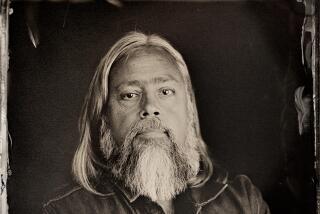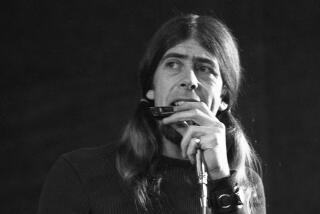‘W.C. Handy’ by David Robertson
W.C. Handy
The Life and Times of the Man
Who Made the Blues
David Robertson
Alfred A. Knopf: 304 pp., $26.95
It’s one of the most familiar creation myths in the American imagination: a lonely crossroads in the Mississippi Delta; a down-at-the-heels musician and Satan himself, come to bestow fretboard mojo in exchange for the poor musician’s very soul. It’s a tale associated with Robert Johnson, but it turns up in different forms here and there. (Remember “The Devil Went Down to Georgia” by the Charlie Daniels Band? More of a showdown than a handshake deal, but similar tableau.) And if this fable isn’t exactly meant to pinpoint the origin of the blues -- an impossible task, after all -- it does enshrine what, for most of us, the blues seem to be all about: the mangled cry of the underclass, the authentic musical bubblings-over of rural primitives, the field holler updated for 20th-century ears.
But in recent years, this Genesis story, reductive and stereotypical as it is, has taken some hard knocks. The first chapter of Elijah Wald’s bracing 2004 biography of Johnson, “Escaping the Delta,” begins: “There has probably been more romantic foolishness written about blues . . . than about any other genre.” Wald goes on to demolish what many cherish about the blues, claiming that the received notions embodied in the crossroads story -- primitivism, poverty, authenticity, early death -- were the revisionist constructions of mid-century white tastemakers and song collectors (read: Alan Lomax).
The theme is now taken up by historian David Robertson in “W.C. Handy: The Life and Times of the Man Who Made the Blues,” an overdue and highly readable account of the man known as the Father of the Blues -- if, really, he’s known at all anymore. Like Wald, Robertson agitates against those past re-writers of blues history who have tended to give Handy -- the Memphis-based musician who first codified and popularized the blues in the 1910s with such rousing hits as “The Beale Street Blues” and “The St. Louis Blues” -- short shrift. In fact, the authoritative online All Music guide contains an allusion to “the less than authentic W.C. Handy” written by Eugene Chadbourne, the frontman of the experimental 1980s indie band Shockabilly and, evidently, a self-appointed blues expert. It’s just this kind of casual prejudice, you imagine, that makes Robertson go crazy.
But it’s not so hard to see how blues historians and fans have not, on the whole, been kind to Handy, a musician once celebrated by the likes of Edmund Wilson and William Faulkner. Whereas classic “country” bluesmen like Johnson and Charlie Patton tended to look like bank robbers, Handy looked like a bank manager: suited, bespectacled and, above all, respectable. These qualities, as Robertson makes clear, were points of pride for Handy, who grew up near Florence, Ala., during the bleakest decades of Reconstruction and Jim Crow. The young Handy was a phenom on piano and, most important, the cornet, with which he’d be associated for the rest of his career. (He died in 1958, the year, Robertson points out, that Elvis -- another guy who clocked time on Beale Street -- entered the Army.)
What, no guitar? Handy’s blues, which hit the American market in 1912 with the release (on sheet music, the form of music distribution then dominant) of “The Memphis Blues, or Mister Crump,” were based on the sound that Handy’s generation grew up with: brass bands.
Listening nowadays to recordings of Handy’s music from the 1910s, you get a strange sensation, and it can be summed up like this: John Philip Sousa’s Got the Blues. Handy was, after all, sometimes known as “the colored Sousa,” yet what he pulled off was no mean trick: Take a triumphal white genre tailored to parade grounds, military encampments and dedication ceremonies, and turn it into something melancholic, swinging and well-suited to saloons, bordellos and dance halls. Even the subject matter of Handy’s songs was arguably daring in ways we take for granted now. Consider “Beale Street Blues,” the 1916 smash that would prompt the city of Memphis to change the name of its most famous thoroughfare from Beale Avenue: “You’ll meet honest men and pick-pockets skilled / You’ll find that business never ceases ‘til somebody gets killed!” It’s not exactly Biggie Smalls, but it’s a far cry from “The Stars and Stripes Forever.”
As Robertson points out, Sousa’s brass is but one source that fed Handy’s imagination. Like all good pop-culture creations, his blues were a decidedly mongrel form, incorporating the uneasy tradition of black minstrelsy (which the young Handy, controversially, dabbled in) and ragtime. Toggling back and forth between, say, “The Maple Leaf Rag” as performed by the United States Marine Band in 1906 and “The Memphis Blues,” by either Columbia’s Prince’s Band or the Victor Military Band eight years later, you hear inevitable continuity. Yet the differences are startling: With “The Memphis Blues,” the very first blues number ever recorded, you encounter the unmistakably familiar 12-bar form -- tricked out with those odd, minor “blue notes” over a major key -- that we still know as the blues. It is this musical vessel, first codified and popularized by Handy, that would end up carrying the two major musical innovations of 20th-century popular music: the extended improvisations of jazz and, conversely, the concise two minutes of ecstasy afforded by a rock’n’roll 45.
But does codifying and popularizing the blues qualify Handy to be the Father of the Blues? In the absence of other contenders (well, maybe Antonio Maggio, who published “I Got the Blues” in 1908 or Jelly Roll Morton, a tireless self-propagandist and perpetual thorn in Handy’s side), why not? Surely, plenty of early 20th century band leaders turned up their noses at the raw music that Handy viewed as raw material for great compositions. It was Handy, Robertson argues, who first brought African American musical culture to a mainstream audience, on a scale that -- thanks to the powers of mass-produced sheet music and the rising recording industry -- dwarfed the earlier appropriations of minstrelsy and white songwriters like Stephen Foster. And it led to something of a feedback loop, as Handy’s hits spread the blues across the country -- including the Delta where Handy first heard them in rudimentary form in 1903 -- inspiring fresh waves of blues artists.
If the final chapters of “W.C. Handy” have the feel of a long, drawn-out coda -- with Handy relocating to Harlem and becoming more of a businessman and living legend than an active composer -- it’s still a remarkable musical journey. And it’s one that continues. Like Handy’s beloved Beale Street (where the musician still resides today, in statue form), the blues may have long ago become safe, commercialized simulacra for white audiences looking to party, but their spirit lives on in the scruffier realms of rock, hip-hop and American culture at large. What Handy fathered goes way beyond the blues.
Rozzo is a critic in Brooklyn, N.Y.
More to Read
The biggest entertainment stories
Get our big stories about Hollywood, film, television, music, arts, culture and more right in your inbox as soon as they publish.
You may occasionally receive promotional content from the Los Angeles Times.










